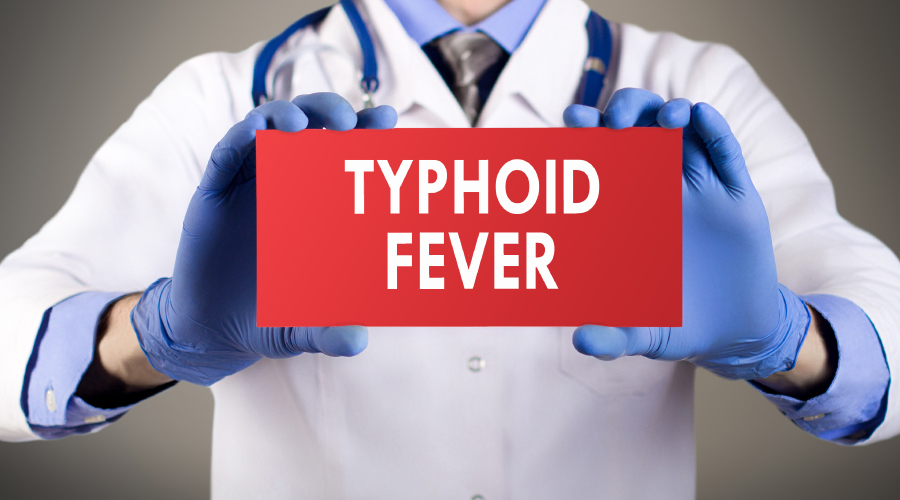

Typhoid fever is a severe illness caused by a bacterium known as Salmonella Typhi. This infection is typically spread through consuming contaminated food or water. After ingestion, Salmonella Typhi bacteria multiply and enter the bloodstream, potentially affecting various organs. If not treated promptly, typhoid can lead to severe complications and even be life-threatening. Read on to learn about typhoid fever symptoms and treatment.
What Causes Typhoid?
As mentioned previously, Salmonella Typhi (S. Typhi) is the bacteria that causes typhoid fever. People who live in places where outbreaks frequently occur are more likely to get exposed to this pathogen. Infected people expel the bacteria in their stool. The bacteria can spread from hands to items or other people if they don’t properly wash their hands after using the washroom. Furthermore, raw fruits without a peel or other uncooked food might act as a carrier for the germs. Contaminated water sources can spread the bacterium in areas where water isn’t treated to get rid of germs. Moreover, you can contract the infection by ingesting unpasteurised milk or juice, drinking untreated water, or eating ice made from such water.
Symptoms of Typhoid
The primary typhoid symptoms include:
- A persistent high fever that gradually rises each day
- General body aches and pains
- Headache
- Extreme fatigue
- Constipation
- Cough
- Chills
As the infection advances, you might experience nausea, abdominal pain, loss of appetite, and diarrhoea. Some individuals may also develop a rash. Without treatment, the symptoms can worsen over time, increasing the risk of potentially life-threatening complications.
Complications of Typhoid
If left untreated, typhoid can result in some severe complications, such as:
- Intestinal perforation (a hole in your intestines)
- Internal bleeding
- Swollen or burst gallbladder
- Swelling around your brain (meningitis)
- Neurological (brain) symptoms, including delirium, confusion and seizures
- Pneumonia, bronchitis or other respiratory issues
- Heart inflammation
- Bone inflammation (osteomyelitis)
- Miscarriage
- Kidney failure.
Typhoid Treatment
Antibiotics are used to treat typhoid. As antibiotic-resistant variants of Salmonella Typhi have emerged, the kind of typhoid and the location where the illness is contracted are factors in the selection of medications. Ciprofloxacin, ofloxacin, levofloxacin, ceftriaxone, cefixime, cefotaxime, azithromycin, and carbapenems are frequently used antibiotics for typhoid fever treatment. Steroids like dexamethasone may be prescribed in extreme situations. It is essential that you take antibiotics as prescribed by your doctor for the full prescribed duration. In order to find out if taking non-steroidal anti-inflammatory medicines (NSAIDs), such as ibuprofen, naproxen sodium, or acetaminophen, for fever or discomfort is safe, you should also speak with your doctor. Most patients who receive early antibiotic therapy begin to feel better in a few days, though it may take somewhere between a week and ten days for them to fully recover.
Typhoid Prevention
Vaccination against typhoid fever is available and is recommended for people living in or travelling to areas where typhoid is common. However, the protection provided by these vaccines diminishes over time, necessitating repeat immunisations. Since the vaccine does not offer complete protection, it is crucial to follow these guidelines when in high-risk areas:
Wash Your Hands
Regular hand-washing with hot, soapy water is essential for infection control. Wash your hands before eating or preparing food and after using the toilet. Carry an alcohol-based hand sanitiser for situations where soap and water are unavailable.
Avoid Using Untreated Water
In areas where typhoid fever is prevalent, contaminated drinking water is a common problem. Drink only bottled water, canned or bottled carbonated beverages. Carbonated bottled water is safer than non-carbonated bottled water as the process of carbonation may help kill some bacteria. Avoid drinks with ice, use bottled water to brush your teeth, and try not to swallow water while showering.
Avoid Raw Vegetables and Fruits
Raw products might be washed with contaminated water, so avoid fruits and vegetables you cannot peel, especially lettuce. It is safer to avoid raw foods altogether in such areas.
Choose Hot Foods
Steaming hot foods are generally safer than foods stored or served at room temperature. Avoid uncooked foods to reduce the risk of infection.
Conclusion
The dangerous illness known as typhoid fever is brought on by the Salmonella Typhi bacteria and is typically contracted through tainted food and drink. If the infection is not treated right away, it may cause serious problems. Headaches, body aches and gastrointestinal problems are the predominant symptoms, along with a persistently high fever. Antibiotics are the mainstay of treatment; the specific drug used will depend on the kind and location of the infection. Typhoid can be avoided in large part by adopting preventive measures, such as immunisation and good hygiene. Following these recommendations can dramatically reduce the risk of contracting typhoid infection, even in high-risk locations.




